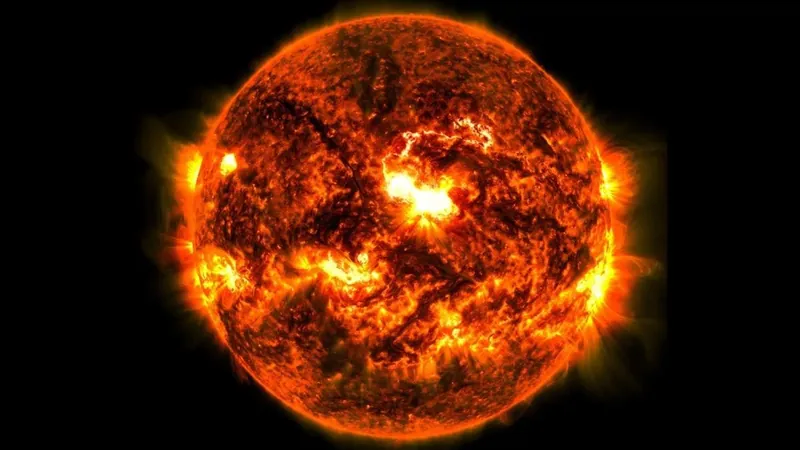
Unveiling the Sun's Mysterious Magnetic Tornadoes: A New Frontier in Solar Research
2024-11-13
Author: Arjun
Introduction
New groundbreaking research has revealed that the sun could harbor swirling polar vortices akin to tornadoes found on Earth, but with a unique twist powered by magnetic forces instead of temperature differentials. This intriguing revelation comes from a study conducted by researchers at the U.S. National Science Foundation’s National Center for Atmospheric Research (NSF NCAR).
Research Findings
Currently, our view of the sun is largely limited to a face-on perspective, leaving the poles shrouded in mystery. To tackle this challenge, the research team employed advanced computer simulations to explore the dynamics of the sun’s polar vortices. Their findings suggest that these cosmic whirlwinds are driven by the sun’s formidable magnetic fields, providing a stark contrast to Earth’s tornadoes, which are created by variations in atmospheric temperatures.
Lead author Mausumi Dikpati, a senior scientist at NSF NCAR, emphasized the significance of this research, stating, “While we cannot definitively determine what is occurring at the solar poles, our simulations offer an insightful glimpse into potential future observations.”
Polar Vortices Across the Solar System
Polar vortices are not exclusive to the sun; they have been detected on various planets and even moons throughout our solar system. These spinning phenomena arise in the fluid mediums surrounding rotating bodies due to the Coriolis effect. However, the sun’s “fluid” is composed of plasma, which behaves differently than gaseous atmospheres. Hence, one could visualize these solar vortices as magnetic tornadoes, exhibiting the sun’s complex magnetic behavior.
The Rush to the Poles
A noteworthy aspect of the study revolves around a phenomenon termed the "rush to the poles." The research team found that polar vortices typically form around 55 degrees latitude and migrate toward the poles. Interestingly, the magnetic fields at the sun's poles possess opposite polarity to the ring of vortices, which means that during solar maximum—the sun’s most active phase in its 11-year cycle—these vortices trigger a magnetic flip. This transition allows for a magnetic field of opposite polarity at the poles.
Importance of Observations
Researchers noted that these simulations fill in a crucial gap in understanding how the sun’s magnetic field operates near its poles. Furthermore, they suggest that the strength of the magnetic field migrating toward the poles could serve as an indicator for predicting the intensity of upcoming solar cycles.
Challenges in Observation
Despite the compelling nature of these simulations, first-hand observations remain essential for validation. However, capturing this elusive phenomenon requires precise timing, as polar vortices can only be examined outside of a solar maximum, which is currently taking place.
Co-author Scott McIntosh highlighted the challenge this presents, explaining that launching a solar mission to observe the poles is a gamble; it may arrive at an inopportune moment. Therefore, a mission capable of observing the sun’s poles from multiple viewpoints simultaneously would be invaluable in furthering our understanding of these solar vortices and their evolution.
Conclusion
As we edge closer to unraveling the secrets of our star, the exploration of these magnetic tornadoes not only propels solar research forward but also opens new avenues for understanding the sun’s impact on space weather and, ultimately, life on Earth. Stay tuned as we continue to monitor these stunning developments in solar science!
 Brasil (PT)
Brasil (PT)
 Canada (EN)
Canada (EN)
 Chile (ES)
Chile (ES)
 Česko (CS)
Česko (CS)
 대한민국 (KO)
대한민국 (KO)
 España (ES)
España (ES)
 France (FR)
France (FR)
 Hong Kong (EN)
Hong Kong (EN)
 Italia (IT)
Italia (IT)
 日本 (JA)
日本 (JA)
 Magyarország (HU)
Magyarország (HU)
 Norge (NO)
Norge (NO)
 Polska (PL)
Polska (PL)
 Schweiz (DE)
Schweiz (DE)
 Singapore (EN)
Singapore (EN)
 Sverige (SV)
Sverige (SV)
 Suomi (FI)
Suomi (FI)
 Türkiye (TR)
Türkiye (TR)
 الإمارات العربية المتحدة (AR)
الإمارات العربية المتحدة (AR)